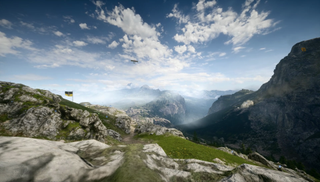Why Monte Grappa is Battlefield 1’s best map
An uphill conflict in the Alps makes use of every tool in Battlefield 1's bag.
Battlefield 1’s Monte Grappa is the first time I stopped to gawk at a multiplayer map—this, despite the tank leveling a building up the road, the biplanes tumbling out of the sky, the steady stream of infantry rally cries curtailing into death rattles, and the angry teen telling me I suck.
Monte Grappa represents the best of Battlefield because it’s the series’ most expressive combat sandbox.
It supports nearly every class build
Boulders and bushes sprout out of the sheer, exposed mountainside at the map’s center with no apparent pattern, the game design opposite of Gears of War 4’s chest-high walls. It’s easy to get lost in the maze of natural cover and end up face to face with an opponent or knife-hugged from behind. But the rough territory encourages close, careful squad play. Assault and support press forward, sniffing out lone enemy infantry like dogs on a pheasant hunt while Medics watch their back and try not to do anything rash.
It looks like someone kicked an anthill filled with army men.
Weapons of any type are viable because conflict happens at nearly every range. Scouts can hang out near the top or bottom of the hill and try to pick off people with a scoped weapon, but a sighted rifle is better for staying mobile. Assault players are just as likely to spot enemies hundreds of yards away as they are to bump into them in the bunkers on point B, C, and D. Grappa may look wide open, but a maze of trenches and boulders make passages make shotguns extremely useful. I’ve specced out every class with every weapon and gadget available to me and found a way to play them. Monte Grappa encourages experimentation, unlike maps like Sinai Desert, where attacking Support players can’t move their team forward without smoke, and snipers have safe perches across an open expanse of desert.
Monte Grappa is always unpredictable. Sometimes I’ll wander to the bottom of the hill just to watch the infantry scramble over and around the terrain, chasing one another in confused circles. It looks like someone kicked an anthill filled with army men.
It evokes how messy WWI tactics were
During World War I, Monte Grappa hosted three major battles between the Kingdom of Italy and the Austro-Hungarian Empire. Home to a strategically vital mountain fortress in the Alps occupied by Italy, it was contested by the Austro-Hungarians in two failed assaults before the Italians drove them out in a final push. The Austro-Hungarians didn’t stand much of a chance. The Italians’ dug-in artillery and underground trenches made assaulting their position a near impossibility. Ignoring that strength in the map would be a waste.
DICE’s interpretation of Monte Grappa captures the same futility the Austro-Hungarians faced. The mountainside slog is the most prolonged, dramatic crawl in all of Battlefield 1. In conquest or rush, the odds probably aren’t stacked one way or the other, but it often feels that way. Following the trenches upward as they wind their way in crooked lines toward an imperfect flanking position beside each fortress gun embedded in the mountain plays off like a cruel joke. Yes, just go around the gun that shoots bullets as big as a toddler. And it’s totally possible to do that, easy with a good team on a less crowded mode, but it’s the image of dozens of tiny, screaming men stumbling up a mountain between rocks and up crowded trenches directly into the line of fire of a van-sized cannon that makes it seem so impossible.
PC Gamer Newsletter
Sign up to get the best content of the week, and great gaming deals, as picked by the editors.
I admire it for letting The Quest for Balance to take a backseat to making me feel something.
The same goes the team on defense, especially in a 64-player Operations match. Beneath each fortress gun is a bunker protecting the gun controls behind two lockable armored doors. They'll only break open with a hefty dose of explosives, and with 32 players focused on defending two points there are usually six people watching each door anyway. The rest of the players just hide, throwing out ammo crates and acting as life preservers. Squads can spawn indefinitely on one another underground, and with a few medics around it’s rare anyone will stay dead at all.
It’s a silly scene, stuffing half the team in a single room, but it drives home how hard it surely was to break this mountain’s defenses. It plays like a deliberately broken mode designed to capture the uneven odds, which makes sense since each Operations match is capped with a few lines of historical context. Pitting the offense against impossible odds is pretty radical for a competitive FPS. I admire it for letting The Quest for Balance to take a backseat to making me feel something, be it fun or hopelessness.
Vehicles are forced to stay mobile
Wheeled vehicles are primarily restricted to the roads that run along the west side of the map. Tanks can shell the mountainside freely but doing so leaves them exposed, and attempting to climb isn’t likely to go well with so many small places for infantry to hide. Using rocket guns and tossing anti-tank grenades from the high ground is a breeze. Besides, tanks are almost required for assaulting an objective on the road that dips below ground and connects with a few passages. It’s a tight fit that forces tanks to work in tandem with infantry on offense, both to sit on the point but also to defend them from flanking fire on the mountainside. But if someone talented is in fortress gun, it’s all over. Because the map is relatively narrow, open, and the road is easy to hit from high up, tanks have almost nowhere to hide in Monte Grappa, which isn’t the case on nearly every other map.
As for air combat, it’s bent into a new shape from Monte Grappa’s long, narrow design, which gives pilots more time to set up bombing runs or low machinegun passes over contested areas, but turns dogfights into games of chicken rather than prolonged, circular pursuits. The mountain's sudden height also means planes will regularly pass over or in front of infantry climbing the hill, keeping one aware of the other and opening up a window to cause some damage. Air combat isn't just some other game happening way over the infantry's head.
And it looks amazing
Which makes destroying it over and over a more effective dramatic arc than anything previous Battlefield games have shot for. DICE has tried layering more thematic levers in its maps before, specifically in Battlefield 4’s map-altering, ooh-wow Levolution moments, where buildings and bridges are leveled in order to change up the map layout and get an action movie rise out of the players. DICE chucks the empty action movie Levolution effects from Battlefield 4 and opts for a slower, more subtle emotional payoff this time around. By the end of a round on Monte Grappa, where once stood an old church and a few small homes is smoking rubble. Flaming tank chassis and massive craters speckle a mountainside that I would’ve happily hiked half an hour before.

Battlefield 1’s advanced destruction system leaves the most tranquil setting in the game totally devastated with every round, and it’s hard to ignore, especially knowing that it’s not pulling from fiction. Sure, not every battle from WWI was topped off with a fiery zeppelin crashing into the ground, but it’s the gradual transformation of a peaceful outdoor setting into an upturned smoking hellscape that gets me every time, and it’s most effective on Monte Grappa.
It’s a breathtaking mountain scene ripped to shreds on repeat and a map designed to frustrate as much as it entertains. Draped over with a thin sheet of WWI context, I’m impressed that a multiplayer map is capable of stirring up empathy for the scars the war left on this nice planet and those who were swept up in its terrible odds while propping up the choice and chaos Battlefield sandboxes are known for.
James is stuck in an endless loop, playing the Dark Souls games on repeat until Elden Ring and Silksong set him free. He's a truffle pig for indie horror and weird FPS games too, seeking out games that actively hurt to play. Otherwise he's wandering Austin, identifying mushrooms and doodling grackles.
Most Popular



